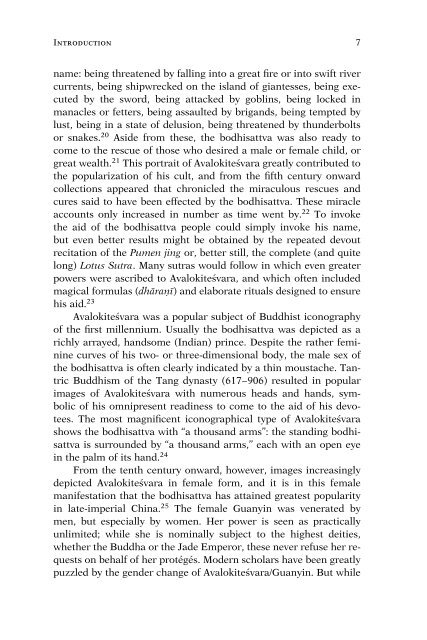Two Precious Scroll Narratives of Guanyin and Her ... - Khamkoo
Two Precious Scroll Narratives of Guanyin and Her ... - Khamkoo
Two Precious Scroll Narratives of Guanyin and Her ... - Khamkoo
Create successful ePaper yourself
Turn your PDF publications into a flip-book with our unique Google optimized e-Paper software.
Introduction 7<br />
name: being threatened by falling into a great fire or into swift river<br />
currents, being shipwrecked on the isl<strong>and</strong> <strong>of</strong> giantesses, being executed<br />
by the sword, being attacked by goblins, being locked in<br />
manacles or fetters, being assaulted by brig<strong>and</strong>s, being tempted by<br />
lust, being in a state <strong>of</strong> delusion, being threatened by thunderbolts<br />
or snakes. 20 Aside from these, the bodhisattva was also ready to<br />
come to the rescue <strong>of</strong> those who desired a male or female child, or<br />
great wealth. 21 This portrait <strong>of</strong> Avalokiteśvara greatly contributed to<br />
the popularization <strong>of</strong> his cult, <strong>and</strong> from the fifth century onward<br />
collections appeared that chronicled the miraculous rescues <strong>and</strong><br />
cures said to have been effected by the bodhisattva. These miracle<br />
accounts only increased in number as time went by. 22 To invoke<br />
the aid <strong>of</strong> the bodhisattva people could simply invoke his name,<br />
but even better results might be obtained by the repeated devout<br />
recitation <strong>of</strong> the Pumen jing or, better still, the complete (<strong>and</strong> quite<br />
long) Lotus Sutra. Many sutras would follow in which even greater<br />
powers were ascribed to Avalokiteśvara, <strong>and</strong> which <strong>of</strong>ten included<br />
magical formulas (dhāraṅī) <strong>and</strong> elaborate rituals designed to ensure<br />
his aid. 23<br />
Avalokiteśvara was a popular subject <strong>of</strong> Buddhist iconography<br />
<strong>of</strong> the first millennium. Usually the bodhisattva was depicted as a<br />
richly arrayed, h<strong>and</strong>some (Indian) prince. Despite the rather feminine<br />
curves <strong>of</strong> his two- or three-dimensional body, the male sex <strong>of</strong><br />
the bodhisattva is <strong>of</strong>ten clearly indicated by a thin moustache. Tantric<br />
Buddhism <strong>of</strong> the Tang dynasty (617–906) resulted in popular<br />
images <strong>of</strong> Avalokiteśvara with numerous heads <strong>and</strong> h<strong>and</strong>s, symbolic<br />
<strong>of</strong> his omnipresent readiness to come to the aid <strong>of</strong> his devotees.<br />
The most magnificent iconographical type <strong>of</strong> Avalokiteśvara<br />
shows the bodhisattva with ‘‘a thous<strong>and</strong> arms’’: the st<strong>and</strong>ing bodhisattva<br />
is surrounded by ‘‘a thous<strong>and</strong> arms,’’ each with an open eye<br />
in the palm <strong>of</strong> its h<strong>and</strong>. 24<br />
From the tenth century onward, however, images increasingly<br />
depicted Avalokiteśvara in female form, <strong>and</strong> it is in this female<br />
manifestation that the bodhisattva has attained greatest popularity<br />
in late-imperial China. 25 The female <strong>Guanyin</strong> was venerated by<br />
men, but especially by women. <strong>Her</strong> power is seen as practically<br />
unlimited; while she is nominally subject to the highest deities,<br />
whether the Buddha or the Jade Emperor, these never refuse her requests<br />
on behalf <strong>of</strong> her protégés. Modern scholars have been greatly<br />
puzzled by the gender change <strong>of</strong> Avalokiteśvara/<strong>Guanyin</strong>. But while

















